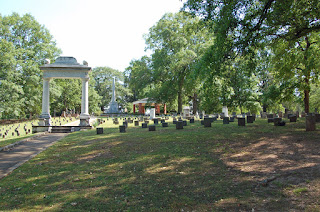A battle produced
ghastly numbers of dead: 3,100 at Gettysburg; 2,843 at Second Manassas; 1,900 at
Franklin. Bodies needed to be interred as quickly as possible, a task usually
left to the victor that held the field. Sometimes the dead were buried where
they fell, and at other times they were gathered and interred in trenches.
The battle of
Chickamauga was fought in September 1862. While it was a Confederate victory, almost
4,000 soldiers from both sides were killed. Confederate forces buried the vast
majority after the battle was over. Once the conflict ended, the war-ravaged
landscape was littered with more than 700,000 graves. The Federal government
was quick to establish a program to disinter Federal soldiers from various
battlefield and hospital sites and re-inter their dead in what became National
cemeteries. (National cemeteries were established by an act of Congress on July
17, 1862.)
Confederate dead
were untouched by the hands of the government. Instead, Southern civilian
organizations were formed for the purpose of finding and relocating the graves
of fallen soldiers. Because of laws that prevented former Confederate soldiers
from gathering, much of the work fell to women. A group of thirteen women met
in July 1866 in Resaca, Georgia, and formed a “Ladies Memorial Association.” About
this same time, Mary Green, instrumental in the formation of the Ladies Memorial
Association, began working on a cemetery for Confederate soldiers killed and
buried near her home in Resaca. When the project was finished in October 1866,
over 450 soldiers had been reinterred.
Resaca was just one small portion of the fighting in North Georgia during the war. Mary Green approached the Georgia Legislature for funding, which, despite the impoverished condition of the state government, agreed to help. They not only agreed to pay off what remained of the bill for re-interring Confederate dead from the Resaca battlefield, but also agreed to an additional $3,500 for a cemetery for the Confederate dead from the Chickamauga battlefield. A site was chosen in Marietta, Georgia. The site was adjacent to the Western and Atlantic Railroad, and was an already established Confederate cemetery, begun in 1863, next to the Marietta City Cemetery. There were soldiers buried here who had died in a train crash, and some who had died in area hospitals. Mrs. Jane Porter Glover of Marietta donated the property for the cemetery expansion.
There were three
different groupings in which the work was carried out. The first took place in
July and August 1867, when fourteen graves were removed. Beginning in October
1867, 151 more soldiers were removed from the Chickamauga battlefield. In 1869,
a third group of removals began, and eventually, 615 Confederate soldiers
killed at Chickamauga were reburied at the Marietta Confederate Cemetery. The group
then began searching for burials in and around Ringgold, Kolb’s Farm, Tunnel
Hill, and parts of the Atlanta Campaign.
Besides holding the
remains of graves of Confederate soldiers who died during the war, the Marietta
Confederate Cemetery was also the burial location for some of the men who died in
the old Confederate soldier’s home in Atlanta. The Marietta Confederate
Cemetery is one of the largest in the South, probably behind Hollywood Cemetery
(18,000 graves) and Oakwood Cemetery (17,000 graves), both in Richmond, and
Blandford Church Cemetery in Petersburg, Virginia, with 30,000 Confederate
graves. At the Marietta Confederate Cemetery, there are markers for some of the
soldiers, markers for various states represented in the cemetery, and a statue honoring
Mary Green.
I last visited this
site in May 2008.


No comments:
Post a Comment